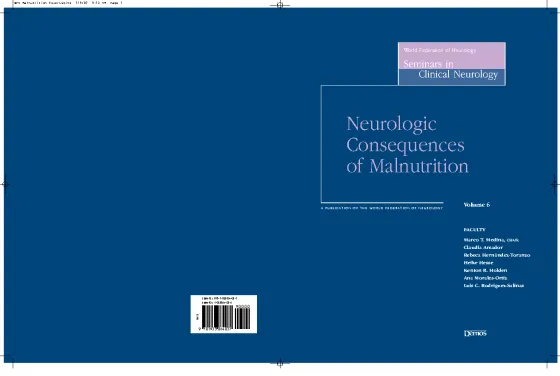Document Download: Neurologic Consequences of Malnutrition

Description:
Neurologic Consequences of Malnutrition, edited by Marco Medina, MD, addresses a crucial cause of neurologic dysfunction that is particularly prominent in the developing world. Funding for this program is provided by unrestricted educational grants.
Released: 4 Dec 2007
Published: 8 Jul 2016
Preface
The recent report from the World Health Organization (WHO), Neurological Disorders: Public Health Challenges, reveals that up to one billion people worldwide are affected by neurologic disorders, constituting 6.3% of the global burden of diseases. This is a strong warning about the overall impact of these disorders, which are also an important cause of mortality and already represent 12% of total deaths around the world. In addition, 92 million of daily-adjusted life years (DALYs) were lost in 2005 as a direct result of this group of diseases and a rising trend is being projected. Neurologic disorders affect people in all countries, irrespective of age, sex, education, or income.
Disorders related to malnutrition, while potentially preventable, produce moderate to severe disabilities. Nearly 800 million people in the world do not have enough to eat, most of them living in developing countries. In these regions, inadequate amounts of food (causing conditions such as child malnutrition and retarded growth) and inadequate diversity of food (causing micronutrient deficiencies) continue to be priority health problems. Malnutrition increases the risk of disease and early death and affects all age groups, but it is especially common among poor people and those with inadequate access to health education, clean water, and sanitation.
Continuing with the Seminars in Clinical Neurology series, the World Federation of Neurology (WFN) would like to emphasize (1) the significance of neurologic diseases related to malnutrition, (2) the importance of early detection and opportune treatment, particularly to avoid development abnormalities, and (3) the severe physical disability that they can produce. Since this material is directed to neurologists from underdeveloped countries, this text has been divided into topics that we consider to be useful for specialists who have a lack of resources and are exposed to a significant number of patients with these types of disorders. As chair of this course, we (1) assembled a multinational group of expert neurologists who remain in permanent contact with patients that suffer neurologic diseases associated with malnutrition, (2) performed an extensive review of recognized literature, particularly from developing countries, and (3) added interesting clinical cases that we considered to be educationally beneficial for the reader.
In Chapter 1, Drs. Rodríguez-Salinas, Amador, and Medina provide a global overview of the epidemiology and magnitude of malnutrition and neurologic disorders. A brief explanation of the clinical and functional assessment of undernourished patients is described, particularly in patients with serious protein-energy malnutrition (PEM) which can lead to severe clinical presentations of marasmus and kwashiorkor. Finally, an extensive and complete classification of the different micronutrient deficiencies related to neurologic syndromes is presented along with a complete description of each of these entities and the secondary disorders that they produce.
Dr. Holden shows us that nutrients clearly play a direct role in the neurobiology of the central nervous system and consequently in its development (Chapter 2). The severity of the impact of malnutrition depends on the severity and duration of the nutritional deficiency, the developmental stage at which the deficit occurred, the preexisting biological condition of the child, and the socio-economic context of the child. Factors such as the amount of breast feeding, a small for gestational age birth weight, and deficiencies in iodine, iron, or protein can be associated with long-term deficits in cognition, school achievement, and behavior. An encouraging note is the degree to which the neurologic system can recover from the impact of malnutrition under certain conditions.
In Chapter 3, Dr. Ana Morales-Ortíz, with the assistance of Dr. Rodríguez-Salinas and Dr. Medina, establishes the relationship between alcoholism and malnutrition. This association is a major public health challenge in developing nations. Globally, the incidence of malnutrition in chronic alcoholics is estimated to be between 5 and 40%. Alcohol can produce malnutrition through two mechanisms: a primary mechanism which replaces other nutrients in the diet and a secondary mechanism which produces a reduction in absorption, digestion, and use of essential nutrients. A considerable number of neurologic diseases are the result of this harmful association.
Finally, Dr. Hernández-Toranzo et al in Chapter 4, describe the different neurophysiologic findings in undernourished patients.
We present this material in an effort to provide a useful source for neurologists in developing countries as they confront neurologic diseases related to malnutrition.
Marco T. Medina, MD
Tegucigalpa, Honduras







